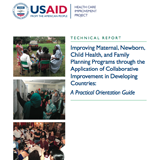
Modern quality improvement methods benefit from the value of teamwork, supportive coaching of teams, process analysis of services, and the use of data to monitor results and decision making. Based on these values, the collaborative improvement approach has taken these principals further by adding the features of multiple quality improvement teams working on the same objective, shared learning, friendly competition, and rapid scale-up of improvement. Collaborative improvement recognizes that team members who are providing a certain service bring valuable insights regarding the process of service delivery, and hence they are more likely to come up with innovative ideas to improve the process and the service outcome. When applied to the health field, the approach empowers health staff themselves to identify performance gaps, suggest and test ideas to improve results in a specific period of time, and share their experience and learn from others.
This guide provides an orientation to health professionals in developing countries who select to use the collaborative improvement approach to increase the effectiveness of health services such as maternal, newborn, child health, and family planning. The guide is not meant to summarize literature or assemble implementation tools. It is meant to provide practical guidance to potential users of the approach, particularly in the area of maternal, newborn, child health, and family planning, so that they can implement it successfully and measure its impact, with little or no external technical assistance.